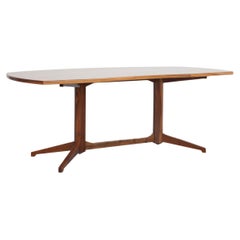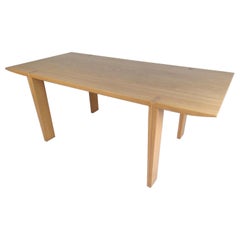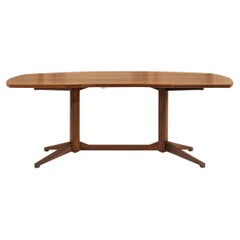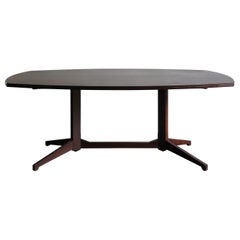Franco Albini and Franca Helg Tables
1
to
1
1
1
1
1
1
1
1
Height
to
Width
to
Depth
to
1
1
1
1
41
415
176
150
144
Creator: Franco Albini and Franca Helg
Dining Table, Model TL22, in Mahogany by Albini & Helg for Poggi, Italy 1958
By Franco Albini and Franca Helg, Pozzi
Located in Hellouw, NL
Beautiful model 'TL22' dining table by Franco Albini and Franca Helg for Poggi, from 1958. The architects Albini and Helg worked together on a large number of projects from 1951 unti...
Category
1950s Italian Mid-Century Modern Vintage Franco Albini and Franca Helg Tables
Materials
Mahogany
Related Items
Desk Model TL22, by Franco Albini and Franca Helg. Poggi, 1958
By Franco Albini and Franca Helg, Amando Poggi
Located in Wolfurt, AT
Desk model TL22, designed by Franco Albini and Franca Helg and manufactured by Poggi in 1958.
Table completely restored. Wood: walnut.
Letteratura: Gramigna G., Repertorio del desig...
Category
1950s Italian Mid-Century Modern Vintage Franco Albini and Franca Helg Tables
Materials
Walnut
Vintage Italian Dining Table by A. Sibau
By A. Sibau
Located in Brooklyn, NY
Impressive dining table by Antonio Sibau. Interesting design with unusual dovetailed lap joinery connecting the legs to the tabletop. Great addition to a...
Category
1980s Italian Mid-Century Modern Vintage Franco Albini and Franca Helg Tables
Materials
Wood
Dining Table by Edward Wormley for Dunbar, Rectangular Bleached Mahogany
By Dunbar Furniture, Edward Wormley
Located in Kansas City, MO
Mahogany dining table with one leaf designed by Edward Wormley for Dunbar, 1950s. The table is in very good condition with only light signs of use under close examination. Beautiful ...
Category
1950s American Mid-Century Modern Vintage Franco Albini and Franca Helg Tables
Materials
Mahogany
Gianfranco Frattini Round Dining Table for Bernini in Exotic Hardwood, Model 522
By Bernini, Gianfranco Frattini
Located in Grand Cayman, KY
1960s Mid-Century Modern Italian round dining table, model 522, by Gianfranco Frattini for Bernini.
Clean, sculptural and Rationalist-influenced geometric and angular forms are fasc...
Category
1960s Italian Mid-Century Modern Vintage Franco Albini and Franca Helg Tables
Materials
Wood, Hardwood, Teak, Walnut
H 28.35 in Dm 51.19 in
Dining Table in Solid Bookmatched Mahogany, Custom Made by Petersen Antiques
By Ken Petersen
Located in Los Angeles, CA
This dining table is made from solid, book-matched African mahogany. Both the top and the legs are book-matched to create a perfectly symmetrical pattern in the wood grain. We design...
Category
2010s North American Mid-Century Modern Franco Albini and Franca Helg Tables
Materials
Mahogany
H 30 in W 126 in D 42 in
Franco Albini TL2 Cavalletto table Poggi Italy 1950
By Franco Albini
Located in Roosendaal, Noord Brabant
Iconic and early example of the TL2 'Cavalletto' table designed by Franco Albini and manufactured by Poggi in Italy around 1950. The table has an amazing dynamic and archtectural sha...
Category
1950s Italian Mid-Century Modern Vintage Franco Albini and Franca Helg Tables
Materials
Brass
Franco Albini Mahogany mid-centry Italian Table Model TL-22 produced by Poggi
By Franco Albini
Located in Barcelona, ES
Franco Albini & Franca Helg.
Dining table model no. TL22.
Manufactured by Poggi,
Italy, 1958.
Mahogany.
Measurements:
180.3 cm x 104.1 cm x 73 H cm.
70.98 in x 40.98 in x 28.74 in.
Literature:
Giuliana Gramigna, Repertorio 1950/1980, Milan, 1985, p. 123.
Franco Albini, was born in 1905 and died in 1977. He spent his childhood and part of his youth in Robbiate in Brianza, where he was born. Albini, as an adolescent moved with his family to Milan. Here he enrolled in the Faculty of Architecture of the Polytechnic and graduated in 1929. He started his professional activity in the studio of Gio Ponti and Emilio Lancia, with whom he collaborated for three years. At the 1929 International Exhibition in Barcelona (where Gio Ponti curated the Italian pavilion and Mies van der Rohe realized that of Germany) and in Paris where, as Franca Helg recounted, he had the opportunity to visit the studio by Le Corbusier.
In those three years, the works he carried out are admittedly of the twentieth century imprint. It is the meeting with Edoardo Persico that marked a clear turning point towards rationalism and the approach to the group of editors of "Casabella". The partly ironic and partly very harsh comments of the Neapolitan critic to a series of drawings, made by Albini for the design of some office furniture, caused him a great disturbance. “I spent days of real anguish - Albini recalls - I had to answer all the questions. I also had a fever, a large and long fever. "
The meted provoked Albini to openen a professional studio in via Panizza with Renato Camus and Giancarlo Palanti. The group of architects began to deal with public housing by participating in the competition for the Baracca district in San Siro in 1932 and then building the IFACP neighborhoods: Fabio Filzi (1936/38), Gabriele D'Annunzio and Ettore Ponti (1939).
During this period, Albini also worked on his first villa (Pestarini), which Giuseppe Pagano, architect and critic of the time, presented as follows: “This coherence, which the superficial rhetoric of fashionable jugglers calls intransigence, and which is instead the basis of understood between the fantasy of art and the reality of the craft, in Franco Albini, it is so rooted that it transforms theory into a moral attitude ".
But it is above all in the context of the exhibitions that the Milanese master experienced his compromise between that "rigor and poetic fantasy" of which Pagano speaks, coining the elements that became a recurring theme in his . The opening in 1933 of the new Triennale headquarters in Milan, in the Palazzo dell'Arte, was an important opportunity to express the strong innovative character of rationalist thinking, a gym in which to freely experiment with new materials and new solutions, but above all a "method". "Cultivated as a communication laboratory, the art of setting up was for the rationalists of the first generation what the perspective had been for the architects of humanism: the field open to a hypothesis of space that needed profound reflections before landing the concreteness of the construction site ".
Together with Giancarlo Palanti, Albini on the occasion of the V Triennale di Milano set up the steel structure house (with R. Camus, G. Mazzoleni, G. Minoletti and with the coordination of G. Pagano), for which he also designed the 'furniture. At the following Triennale of 1936, Persico dided, together with a group of young designers gathered by Pagano in the previous edition of 1933, Franco Albini took care of the preparations of the home exhibition. The setting up of Stanza per un uomo, at that same Triennale, allows us to understand the acute and ironic approach of Albini, as a man and as a designer: "Celebrating the beauty of mechanics was the imperative to which, for example, the surprising displays by Franco Albini who managed, in the subtle way of a refined and rarefied style, to sublimate their practical content in the metaphysics of daring still lifes: flying objects which marked in the void refined frames and metal intricacies the nodes of a fantastic cartography where industry finally became art free from purpose ".
That same year Albini and Romano designed the exhibition of the Ancient Italian Goldsmithery: vertical uprights, simple linear rods, designed the space. A theme, of the "flagpole", seemed to be the center of the evolution of production and the creative process. The concept is reworked over time, with the technique of decomposition and recomposition typical of Albinian design: in the preparation of the Scipione Exhibition and contemporary drawings (1941) the tapered flagpoles, on which the paintings and display cases were hung, are supported by a grid of steel cables; in the Vanzetti stand (1942) they take the V-shape; in the Olivetti shop in Paris (1956) the polished mahogany uprights support the shelves for the display of typewriters and calculators.
The flagpole is found, however, also in other areas. In the apartments he designed, it is used as a pivot on which the paintings can be suspended and rotated to allow different points of view, but at the same time as an element capable of dividing the spaces. The Veliero bookcase...
Category
Mid-20th Century Italian Mid-Century Modern Franco Albini and Franca Helg Tables
Materials
Mahogany
H 28.75 in W 40.95 in D 70.87 in
Franco Albini TL3 Table for Cassina, Italy, new
By Franco Albini, Cassina
Located in Berlin, DE
The price given applies to the piece as seen in the first picture. Prices vary dependent on the size and chosen material of the table. The base is available in solid ash wood or American walnut. The table is available in a rectangular or round version (the latter measures 130 cm in diameter and 75 cm in height)
Table designed by Franco Albini in 1953. Relaunched in 2013. Manufactured by Cassina in Italy. Franco Albini designed this table using the strut element that he had already employed in the design of the Veliero and Infinito bookshelves. In this instance, the legs serve as the vertical elements, solid, turned along their entire surface except for the square section onto which the horizontal table...
Category
21st Century and Contemporary Italian Mid-Century Modern Franco Albini and Franca Helg Tables
Materials
Ash, Walnut, Glass, Wood
Franco Albini TL3 Table, Wood and Glass by Cassina
By Cassina, Franco Albini
Located in Barcelona, Barcelona
Table designed by Franco Albini in 1953. Relaunched in 2013.
Manufactured by Cassina in Italy.
Franco Albini designed this table using the strut element that he had already employed in the design of the Veliero and Infinito bookshelves. In this instance, the legs serve as the vertical elements, solid, turned along their entire surface except for the square section onto which the horizontal table...
Category
2010s Italian Mid-Century Modern Franco Albini and Franca Helg Tables
Materials
Glass, Wood
Franco Albini TL30 Round Table in Metal and Wood for Poggi Pavia 1950s Italy
By Franco Albini, Poggi
Located in Montecatini Terme, IT
Round table model TL30 with black lacquered metal base and a wooden top.
Designed by Franco Albini for Poggi, Pavia in 1950s.
After spending his childhood and part of his youth in Robbiate in Brianza, where he was born in 1905, Franco Albini moved with his family to Milan. Here he enrolled in the Faculty of Architecture of the Polytechnic and graduated in 1929. He starts his professional activity in the studio of Gio Ponti and Emilio Lancia, with whom he collaborates for three years. He probably had his first international contacts here
In those three years, the works carried out are admittedly of a twentieth-century imprint. It was the meeting with Edoardo Persico that marked a clear turning point towards rationalism and the rapprochement with the group of editors of “Casabella”.
The new phase that that meeting provoked starts with the opening of the first professional studio in via Panizza with Renato Camus and Giancarlo Palanti. The group of architects began to deal with public housing by participating in the competition for the Baracca neighborhood in San Siro in 1932 and then creating the Ifacp neighborhoods: Fabio Filzi (1936/38), Gabriele D’Annunzio and Ettore Ponti (1939).
Also in those years Albini worked on his first villa Pestarini.
But it is above all in the context of the exhibitions that the Milanese master experiments his compromise between that “rigor and poetic fantasy” coining the elements that will be a recurring theme in all the declinations of his work – architecture, interiors, design pieces . The opening in 1933 of the new headquarters of the Triennale in Milan, in the Palazzo dell’Arte, becomes an important opportunity to express the strong innovative character of rationalist thought, a gym in which to freely experiment with new materials and new solutions, but above all a “method”.
Together with Giancarlo Palanti, Albini on the occasion of the V Triennale di Milano sets up the steel structure house, for which he also designs the ‘furniture. At the subsequent Triennale of 1936, marked by the untimely death of Persico, together with a group of young designers gathered by Pagano in the previous edition of 1933, Franco Albini takes care of the preparation of the exhibition of the house, in which the furniture of three types of accommodation. The staging of Stanza per un uomo, at that same Triennale, allows us to understand the acute and ironic approach that is part of Albini, as a man and as a designer: the theme addressed is that of the existenzminimum and the reference of the project is to the fascist myth of the athletic and sporty man, but it is also a way to reflect on low-cost housing, the reduction of surfaces to a minimum and respect for the way of living.
In that same year Albini and Romano designed the Ancient Italian Goldsmith’s Exhibition: vertical uprights, simple linear rods, design the space. A theme, that of the “flagpole”, which seems to be the center of the evolution of his production and creative process. The concept is reworked over time, with the technique of decomposition and recomposition typical of Albinian planning: in the setting up of the Scipio Exhibition and of contemporary drawings (1941) the tapered flagpoles, on which the paintings and display cases are hung, are supported by a grid of steel cables; in the Vanzetti stand (1942) they take on the V shape; in the Olivetti store in Paris (1956) the uprights in polished mahogany support the shelves for displaying typewriters and calculators. The reflection on this theme arises from the desire to interpret the architectural space, to read it through the use of a grid, to introduce the third dimension, the vertical one, while maintaining a sense of lightness and transparency.
The flagpole is found, however, also in areas other than the exhibition ones. In the apartments he designed, it is used as a pivot on which the paintings can be suspended and rotated to allow different points of view, but at the same time as an element capable of dividing spaces. The Veliero bookcase...
Category
1950s Italian Mid-Century Modern Vintage Franco Albini and Franca Helg Tables
Materials
Metal
Franco Albini for Poggi Table or Desk, Italy, 1960s
By Franco Albini, Poggi
Located in Almelo, NL
Franco Albini for Poggi table or desk, Italy, 1960s
Walnut table TL22 model by Franco Albini for Poggi Italy 1960s. It is in excellent condition, with a minor patina on the wood parts. This unique table or desk would be an eye-catching addition to any interior, such as a living room, family room, screening room, or office. It also perfectly fits in a hospitality or corporate location like a boutique hotel lobby or luxury loft.
When you choose for used mid...
Category
Mid-20th Century Italian Mid-Century Modern Franco Albini and Franca Helg Tables
Materials
Wood, Walnut
Franco Albini Tl3 Table, Black Dyed Wood and Glass by Cassina
By Franco Albini, Cassina
Located in Barcelona, Barcelona
Table designed by Franco Albini in 1953. Relaunched in 2013.
Manufactured by Cassina in Italy.
Franco Albini designed this table using the strut element that he had already employed in the design of the Veliero and Infinito bookshelves. In this instance, the legs serve as the vertical elements, solid, turned along their entire surface except for the square section onto which the horizontal table...
Category
2010s Italian Mid-Century Modern Franco Albini and Franca Helg Tables
Materials
Glass, Wood
Previously Available Items
Table Designed by Franco Albini, Model Tl-22 Produced by Poggi, Italy 1958 ca.
By Franco Albini and Franca Helg, Poggi
Located in Piacenza, Italy
Walnut Table designed by Franco Albini and Franca Helg, Model TL-22 produced by Poggi, Italy 1958 ca.
Beautiful desk or table with boat shape.
Category
1950s Italian Mid-Century Modern Vintage Franco Albini and Franca Helg Tables
Materials
Wood, Walnut
H 29.14 in W 76.38 in D 37.8 in
Franco Albini and Franca Helg for Poggi Italian Dark Wood Dining Table TL22
By Franco Albini and Franca Helg, Poggi
Located in Reggio Emilia, IT
Italian Mid-Century Modern design dining table designed by Franco Albini and Franca Helg and produced by Poggi Pavia from 1958 with veneered dark wood top with elliptical shaped long...
Category
1950s Italian Mid-Century Modern Vintage Franco Albini and Franca Helg Tables
Materials
Wood
H 28.94 in W 77.17 in D 44.3 in
Franco Albini and Franca Helg Table TL22 Wood Poggi, Italy, circa 1958
By Franco Albini and Franca Helg, Poggi
Located in Milan, IT
The TL22 is a table designed by Franco Albini and Franca Helg to have a cohesive and harmonious structural dimension. The table, exclusively in wood, is formed by a well-proportioned...
Category
Mid-20th Century Italian Mid-Century Modern Franco Albini and Franca Helg Tables
Materials
Wood
H 28.35 in W 82.68 in D 51.19 in
Franco Albini And Franca Helg tables for sale on 1stDibs.
Franco Albini and Franca Helg tables are available for sale on 1stDibs. These distinctive items are frequently made of wood and are designed with extraordinary care. There are many options to choose from in our collection of Franco Albini and Franca Helg tables, although brown editions of this piece are particularly popular. Many of the original tables by Franco Albini and Franca Helg were created in the mid-century modern style in italy during the 1950s. If you’re looking for additional options, many customers also consider tables by Poltronova, Ico Parisi, and Vittorio Dassi. Prices for Franco Albini and Franca Helg tables can differ depending upon size, time period and other attributes — on 1stDibs, these items begin at $9,345 and can go as high as $9,345, while a piece like these, on average, fetch $9,345.



